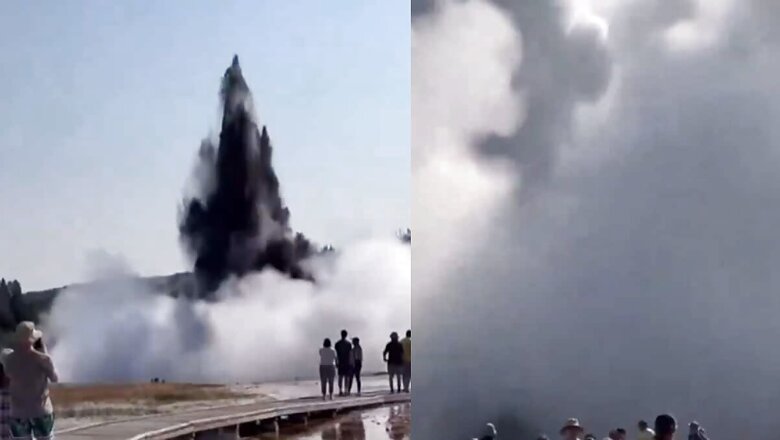
views
A minor hydrothermal explosion happened in Yellowstone National Park, United States at 10 am on Tuesday. The event happened close to Black Diamond Pool, a 120-foot-long hot spring that is a component of the Biscuit Basin thermal region. Visitors captured a number of videos during which they could be seen fleeing the explosion of debris and steam. There were reports of damage to the boardwalk but no injuries. Geologists are looking into the incident and according to reports, Biscuit Basin—including the boardwalks and parking lot—is being temporarily closed for tourist safety.
The explosion occurred not far north of the well-known Old Faithful Geyser. Hundreds of viewers stood on a boardwalk as the geyser’s power increased, culminating in a tremendous explosion that drove debris and water crashing down. Screams of “Holy cow!” and “Back up!” could be heard as tourists scrambled to stay out of the way of the falling pebbles.
WHOA!Crazy eruption and aftermath videos from a geyser located at Biscuit Basin in Yellowstone National Park pic.twitter.com/5rlaXSK9mX
— shawn hannon (@hannon44) July 23, 2024
Speaking with ABC News, scientist Mike Poland of the Yellowstone Volcano Observatory stated that the explosion could have been caused by a blocked channel in the vast natural plumbing network that supports Yellowstone’s renowned geysers, hot springs and other thermal objects. He claimed that a blockage would have resulted in a build-up of heat and pressure similar to that which occurs within a pressure cooker, until the water abruptly flashed to steam, generating an enormous and immediate increase in volume and setting off the explosion.
Poland assessed that the explosion threw material roughly thirty meters (100 feet) into the air after watching footage from the occurrence. The explosion, according to him, was “on the big side” of recurring eruptions, which often happen when nobody is nearby, much less large crowds of visitors.
The explosion’s impact was demonstrated by a large, demolished grey region visible in a US Geological Survey picture. Such hydrothermal explosions, according to the Geological Survey, happen when water in a shallow hydrothermal system quickly changes to steam, forcing the rocks around it to be forcefully released. Although unrelated to volcanic activity, these occurrences have the ability to create sizable craters and send debris up to 2 km into the sky.
#Yellowstone Park staff are on scene assessing conditions after a small hydrothermal explosion occurred today (July 23) in #BiscuitBasin. There are no reports of injuries. The boardwalk, on the other hand, will need a few repairs. The area remains temporarily closed. NPS photos. pic.twitter.com/XrHuUhw7fk— USGS Volcanoes???? (@USGSVolcanoes) July 23, 2024
Similar eruptions have occurred in Biscuit Basin in the past; prominent instances occurred in 2009, 1991 and after a major earthquake in 1959. The biggest explosion-related crater ever measured is 2.4 kilometres in diameter.


















Comments
0 comment